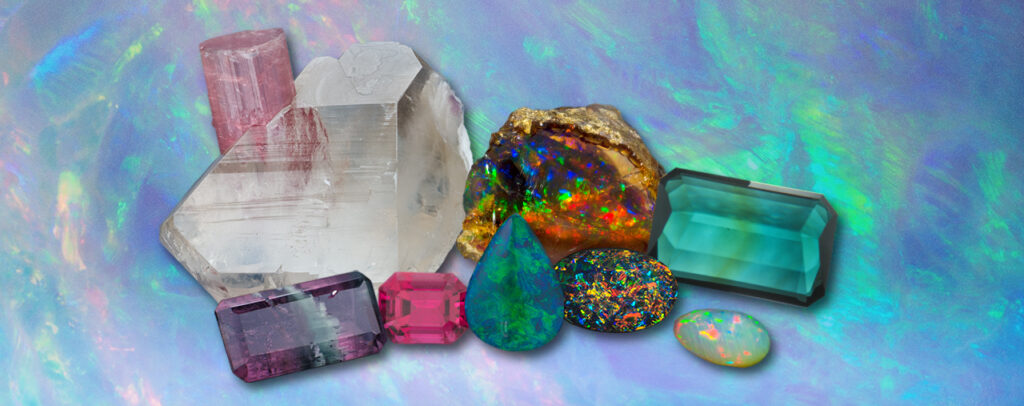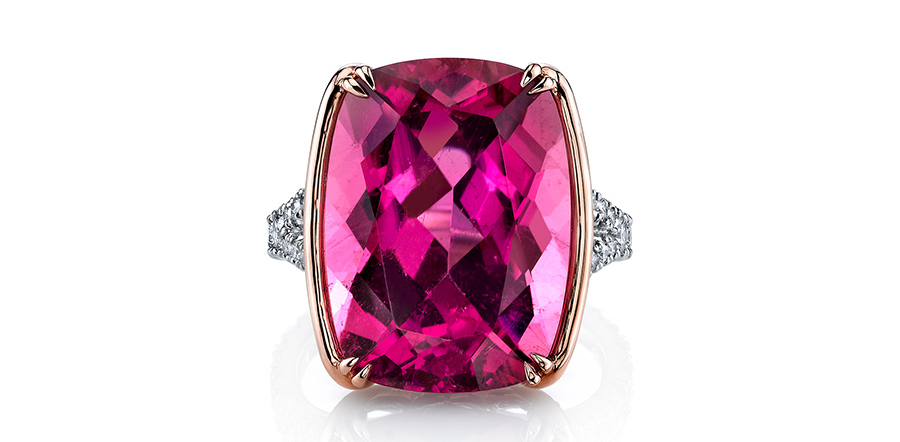October Birthstone
Opal & Tourmaline
October’s birthstones are the opal and tourmaline. These two gemstones are renowned for their inexhaustible colour combinations and are thought to have originated from rainbows. Discover more about these two birthstones for October, including their origins, meanings, and locations.

Opal and tourmaline are two magnificent birthstones that honour those who were born in October. Both birthstones for October offer stunning colouring and countless colour combinations. Discover the ideal present for folks born in the tenth month by learning more about these two birthstones for October.
Opal Birthstone Meaning & History
The name of this traditional October birthstone is thought to have come from Sanskrit, where it was known as upala, or “precious stone,” in India, when the first opals were brought to the West. This was known as opalus in ancient Rome. The majority of opals are prized for their “play-of-color” phenomena, which refers to the shifting colours in rainbow tones.
Writers have compared the stunning colour play of the birthstone for October to fireworks, galaxies, and volcanoes. Opal was previously thought by Bedouins to contain lightning and to fall from the sky during thunderstorms.
Opals were regarded by the ancient Greeks as providing both disease protection and the gift of prophecy. Opal has long been considered by Europeans to be a sign of truth, hope, and purity. Opal was once thought to encapsulate the qualities and powers of all coloured stones.
The stone given in honour of a couple’s 14th wedding anniversary is opal.

Opal Source
Opal is a birthstone that can be found everywhere. The world’s most producing fields for the birthstone for October are in Australia. Brazil, Mexico, and Ethiopia are all significant sources. Additional deposits have been discovered in the United States, Indonesia, Madagascar, Peru, Central Europe, Honduras, and Peru.
A little Australian village called Lightning Ridge is well known for producing valuable black opal. Lightning Ridge is a barren, rocky area that receives little rain and bakes in the sweltering summer heat. It is only softened by a few small trees and bushes. Because of the harsh weather, miners frequently live underground to escape the oppressive heat.

Other varieties of the October birthstone come from Australia. In addition to Mintabie, Andamooka, and Coober Pedy in South Australia, white opal can also be found in the White Cliffs region of New South Wales. Queensland is the only place in the world where boulder opal is mined.

The birthstone for October is found in Ethiopia close to the community of Wegel Tena in the Wollo Province. Opal is extracted from shafts excavated into the slope of a plateau 8,000 feet (2,400 metres) above sea level, 340 miles (nearly 550 km) north of Addis Abeba, Ethiopia. The gemstones found here have a variety of body colours, including white, yellow, orange, brownish red, and “chocolate” brown. Play of colour is visible in several of the opals. In addition to orange, white, and crystal opal, another mine in Ethiopia’s Shewa Province also produces the highly sought-after black opal. Its riches are hidden beneath rocks that rise above the surrounding area.
A state in Mexico called Querétero is renowned for producing fire opal in hues of yellow, orange, and reddish orange to red, some of which have pleasing colour play.The mines are a popular tourist attraction, and accessing them entails travelling on a dirt route that passes through pine and oak forests, scrubby plateaus, and twisting mountain roads.
Opal Care & Cleaning
Opal can be treated by being impregnated with plastic, wax, or oil. Fine opal slices are adhered to a base material and coated with a thin dome of clear quartz to form opal doublets or triplets. Cleaning this October birthstone in warm, soapy water is the safest method. Other cleaning techniques could harm the filler or opal. Be aware that prolonged contact with water may cause the adhesive on opal triplets and doublets to deteriorate. If subjected to intense heat or abrupt temperature changes, even natural opal can fracture.
The hardness of this October birthstone ranges from 5 to 6.5 on the Mohs scale. Opal should be stored alone to avoid scratches from jewellery set with tougher gems. Just a few of the gemstones include emeralds, rubies, sapphires, and diamonds.

Tourmaline Birthstone Meaning & History
The more recent birthstone for October is tourmaline. Due to the frequent presence of several colours in a single crystal, the term is derived from the Sinhalese word toramalli, which means “stone with mixed colours.” Few gems can equal the stunning variety of colours found in tourmaline. It’s possible that this birthstone for October’s month has a colour scheme for every mood, which is why ancient mystics thought it might stimulate artistic expression. The neon green and blue-to-violet “paraba” tourmalines, the pink and red rubellites, and the emerald green “chrome” tourmalines are among the most well-liked varieties.
Tourmaline’s wide range of colours led to frequent confusion with other gemstones. The “Caesar’s Ruby” pendant, one of the “rubies” in the Russian crown jewels, is actually red (rubellite) tourmaline. In the 1500s, a Spanish conquistador discovered green tourmaline crystals in Brazil and mistook them for emeralds. Until tourmaline was identified by scientists as a different mineral species in the 1800s, these and other instances of misidentification persisted for many years.

It is said that tourmaline comes in a variety of therapeutic hues. Black tourmaline is thought to give the wearer protection and a boost of confidence. Pink tourmaline symbolises love and is linked to kindness and compassion. Courage, strength, and stamina are encouraged by green tourmaline. To commemorate the seventh wedding anniversary, tourmaline is given.
Tourmaline Source
The gemstone for October is most frequently found in Brazil, although it is also mined in other African nations like Afghanistan, Pakistan, Kenya, Madagascar, and Mozambique. Fine tourmaline is historically produced in large quantities in California and Maine.

Pegmatites in the state of Minas Gerais have provided the majority of the tourmaline mined in Brazil over the years. A genuine kaleidoscope of gem minerals are produced as a result of these subsurface magma intrusions. However, electrifying green, blue, and violet tourmalines from pegmatites in Brazil’s Paraba State reached the gem market in the late 1980s. Researchers discovered that small levels of copper, which had not before been identified as a colouring factor in any other tourmaline, were responsible for the strong colours. Tourmalines of the Paraba type that contain copper were also found in Mozambique and Nigeria in the early 2000s. Overall, due to their vibrant colours, stronger colour saturation, and increased rarity, the greatest Paraba and Paraba-type tourmalines are easily more expensive than other tourmalines.

Both Southern California and Maine are home to a number of pegmatite districts in the United States. They have sporadically produced significant amounts of tourmaline for over a century.
Two young boys who were exploring the area found Mount Mica near Paris, Maine, around 1820, and this is where Maine’s first significant tourmaline deposit was found. A Mount Mica quarry continues to sporadically produce gem tourmaline in a range of colours. The most frequent source of tourmaline in Maine is the Dunton mine, which is close to Plumbago Mountain.
In the Mesa Grande region, known for producing exquisite rubellite, the Himalaya pegmatite saw the opening of California’s first commercial tourmaline mine in 1898. 120 tonnes of gem rubellite were shipped to Imperial China by San Diego mines between 1902 and 1910 to satisfy Empress Dowager Cixi’s infatuation with the vivid colour. The heyday of tourmaline mining in California came to an end with Cixi’s passing in 1908 and the overthrow of the Qing dynasty that followed. Currently, only a few mines in San Diego County sporadically produce tourmaline of gem quality.
Tourmaline Care & Cleaning
The Mohs hardness scale rates the tourmaline birthstone between 7 and 7.5, making it typically wearable every day. Heat can be harmful, but these vibrant gems are typically stable enough to survive light and the majority of chemicals. The ideal cleaning solution for this birthstone of October is warm, soapy water and a soft brush. It is not advised to use steam or ultrasonic cleaners.

